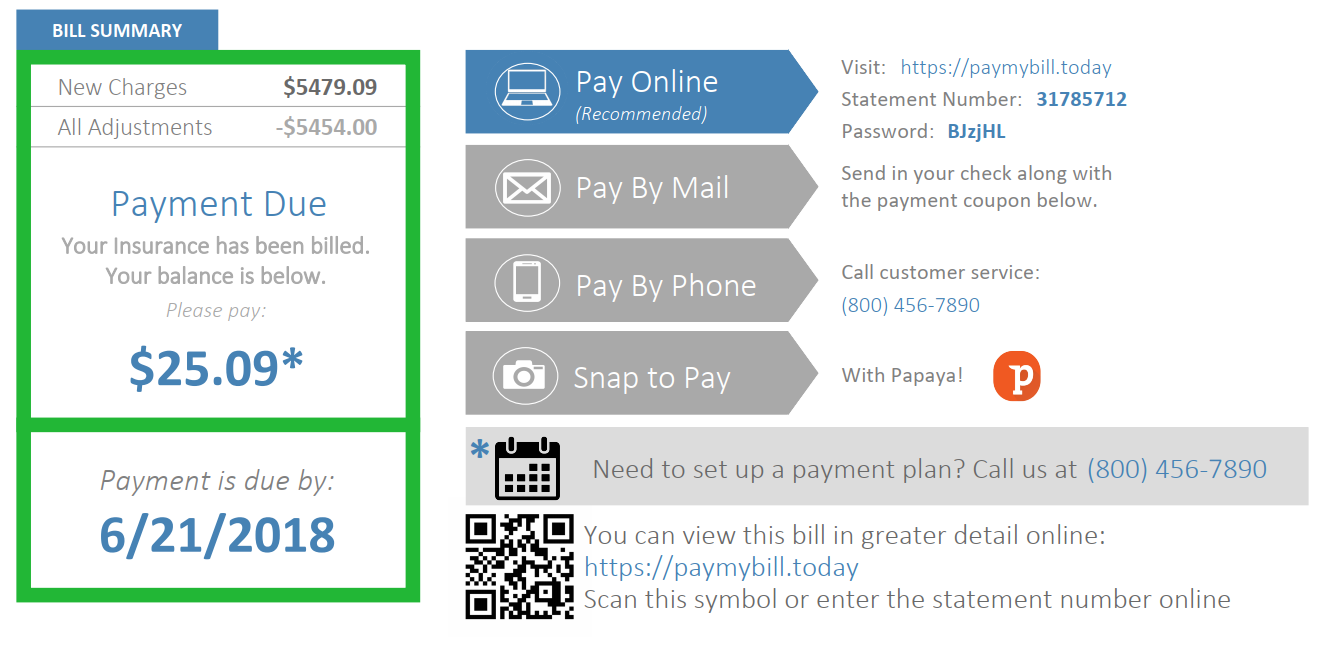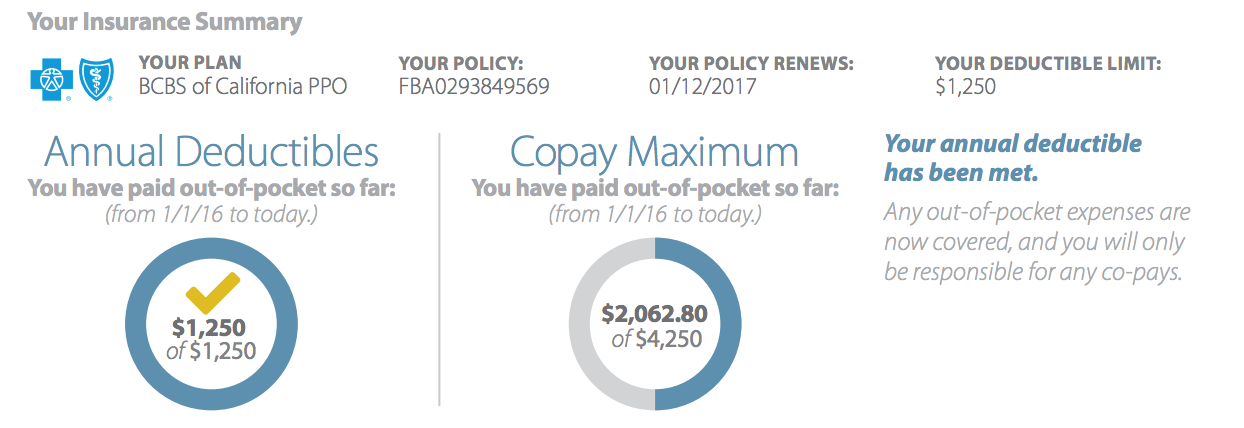Collect More with These 7 Medical Statement Design Tips

Most healthcare practices consider medical statement design an afterthought. Patient invoices are rarely optimized for the collection of patient financial responsibility. Poorly designed healthcare bills result in lower payments received, higher collection costs, and poor revenue cycle management.
Designing statements from the ground up with a focus on maximizing patient payments can keep your patients happy and cash flow positive. Giving patient billing statements an intelligent design and optimizing them for payments will decrease overhead and administrative costs while increasing profit and soothing a troubling revenue management cycle. Here are some medical statement design tips to help you increase your collections without increasing costs.
Personalize Your Medical Statement
Each individual patient is unique, and a one-size-fits-all billing approach will only increase the time balances sitting in patients’ accounts receivables. It is important to personalize each statement to the recipient based on payment history, balance amount, and demographics.
Intelligent bill design gets better over time as it is tailored to each individual patient. Consider offering a discount for prompt payment to a patient who has been persistently delinquent. Proactively promote your patient portal and ensure that you offer mobile payment options.
Simplicity appeals to busy patients on the go. Optimizing your billing statements with a focus on decreasing time in patients’ accounts receivables means offering multiple payments and customer service options. Offer as many different payment options as your office can accommodate so that each patient can choose the right option for them.
Two of your most valuable tools will be an Integrated Voice Response to facilitate easy phone payments and a one-click payment option from your website. Don’t forget your ESL patients in the process. If possible, provide at least minimal translation when it comes to patient billing statements.

Simplify the Medical Statement
Patients aren’t interested in deciphering their medical billing statements. Complicated statements full of medical jargon only lead to patient confusion. Complex, wordy prose leads to patient rejection. The best practice is to keep billing statements simple and write in a friendly, conversational tone.
Billing statements written in an active voice using possessive pronouns helps relieve financial-related anxiety induced by reading medical invoices. Avoid using long, overly complicated sentences and phrases. Instead, craft clear, concise statements that are to the point. Your billing statement language should mimic the way your care providers and support staff interact with each patient in person.
Make it Comprehensive
An intelligent medical billing statement is comprehensive, not complicated. The most important information should be presented first, and it should stand out. The outstanding balance and the due date should be prominently displayed multiple times on the first page. It should also be given priority placement at the top of the page.
Transactional information should be separated and summarized in an easy-to-read format. Be sure to include any itemized data relevant to the patient’s current charges and clearly communicate your payment terms, including any prompt payment discounts. Personal, intuitive billing leverages customer information. Incorporating a list of Frequently Asked Questions is a great way to anticipate the needs of your patients and avoid expensive support calls. Just be sure to keep it manageable, paying careful attention to the size and scope of your FAQs.
Use Visual Influence to Guide the Reader’s Eye
Your medical statement is a critical interaction with your patient. As such, you want to guide them through with visual influence. Using in-text design elements is a great way to direct the reader’s path. As stated earlier, the balance due and the due date should be given prominent placement and it should stand out in bold letters.
Many patients scan their statements rather than read them in detail, so you want to use color and contrast to highlight critical information. Contrast is also the best way to lead the reader’s eye through the flow of the statement. Use plenty of white space to relax the reader and consider a grid approach to avoid busy statements with crowded wording. Bold headlines and bulleted lists can help segment key details without congesting the billing statement. You’ll also want to put significant emphasis on payment channels and service information. It is best to use a large font as many Americans have a visual impairment that might prohibit them from reading smaller print.

Leverage the Benefits of Electronic Statements (eStatements)
Delivering electronic statements is an intelligent way to cater to the needs of your patients while simultaneously providing simple payment methods. Patients should opt-in on the date of service as part of the check-in process. Use links that pre-populate common fields to simplify the process and enhance patient satisfaction.
This one simple practice reduces paperwork, simplifies the check-in process, and slashes the amount of time it takes for patients to answer questions. The eStatement medium delivers immediate advantages by abating delivery, postage, and administrative costs. It also allows you to send email notifications and initiate important engagement regarding billing statements and payments. Electronic statements make it easier for patients to pay with direct links or quick click payment options, significantly reducing the number of days a patient’s balance is in accounts receivables.
Ensure Accuracy Before Delivery
It is critical that patient billing statements are accurate when they are delivered. Billing mistakes will negatively impact both days in accounts receivable and profitability. Even a due date error demands costly staff attention and resolution, so it should be avoided at all costs. \
Any outsourced billing partner should be HITRUST-certified and use a cross-reference technology to ensure that each billing statement is accurate beyond the shadow of a doubt. All data management and statement production techniques should incorporate intelligent, intuitive design with a bulletproof approach that ensures compliance and accuracy. Even seemingly benign mistakes can expose patient data and damage your reputation as a healthcare provider. The additional layer of security provided by your outsource billing partner can help ensure statement accuracy and speed up the payment process for a positive impact on your patient revenue cycle.

Use Analytics to Test and Improve Over Time
Analyzing metrics is the best way to improve over time. This includes the billing and payment process. You want to closely track the number of payments received within a time period and cross-reference them with the number of support calls sustained during the same window of time. This process will tell you what is working and what isn’t, so you can focus your efforts on a design that diminishes time in patients’ accounts receivables and strengthens the revenue cycle. Patient satisfaction is also a big indicator of accelerated payments. Ask for your patients’ input and integrate it into your processes.
The bottom line is that healthcare billing statements have a dramatic effect on the overall revenue stream and profitability. Acknowledging this and understanding the fundamental elements of statement design that impact the payment process is the first step toward increasing collections. Partner with a HITRUST-certified billing and statement provider which understands the importance of key elements that will accelerate the payment process and soothe the troubled patient revenue management cycle.

Michael Bell is the Chief Marketing Officer for MailMyStatements. Mike is a dynamic, innovative thinker, a healthcare technology advocate, a consumer, a patient, and an avid golfer.
Follow him on Twitter!




Comments
Post a Comment